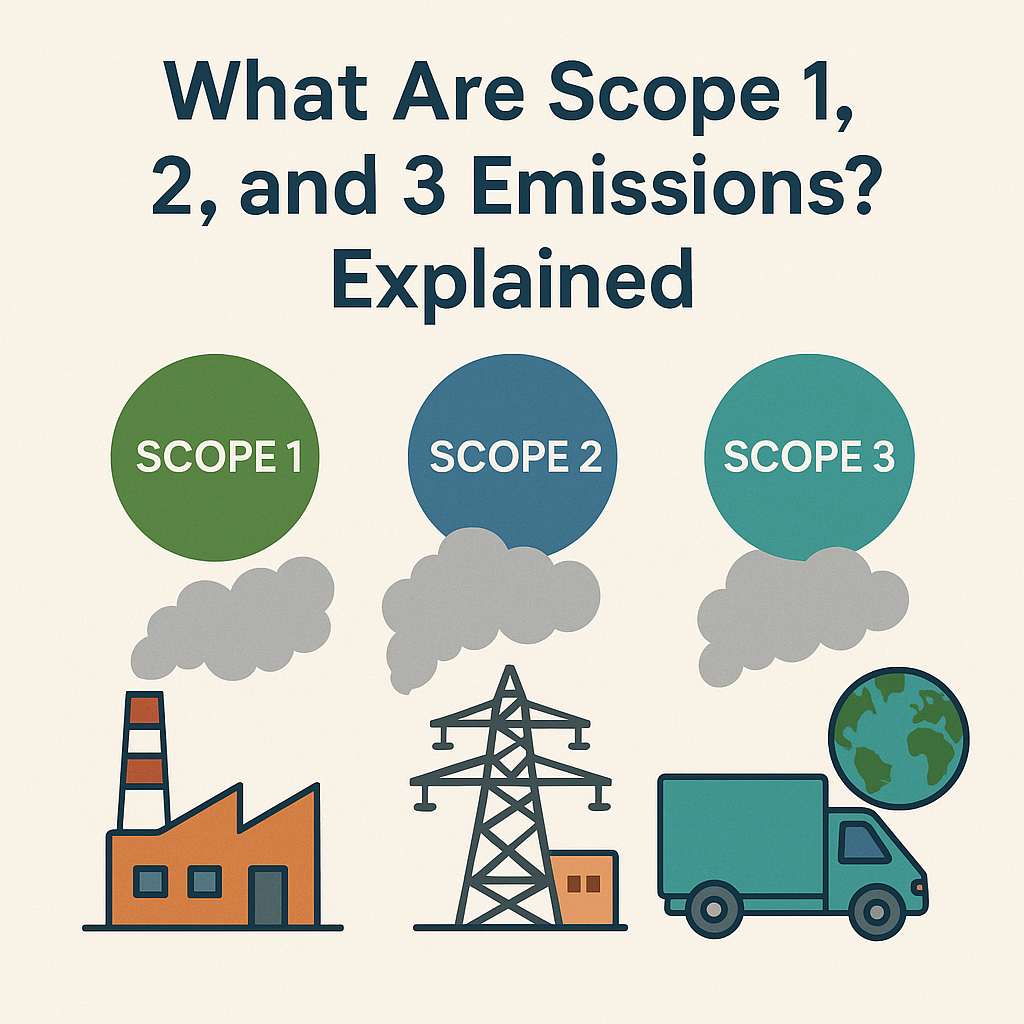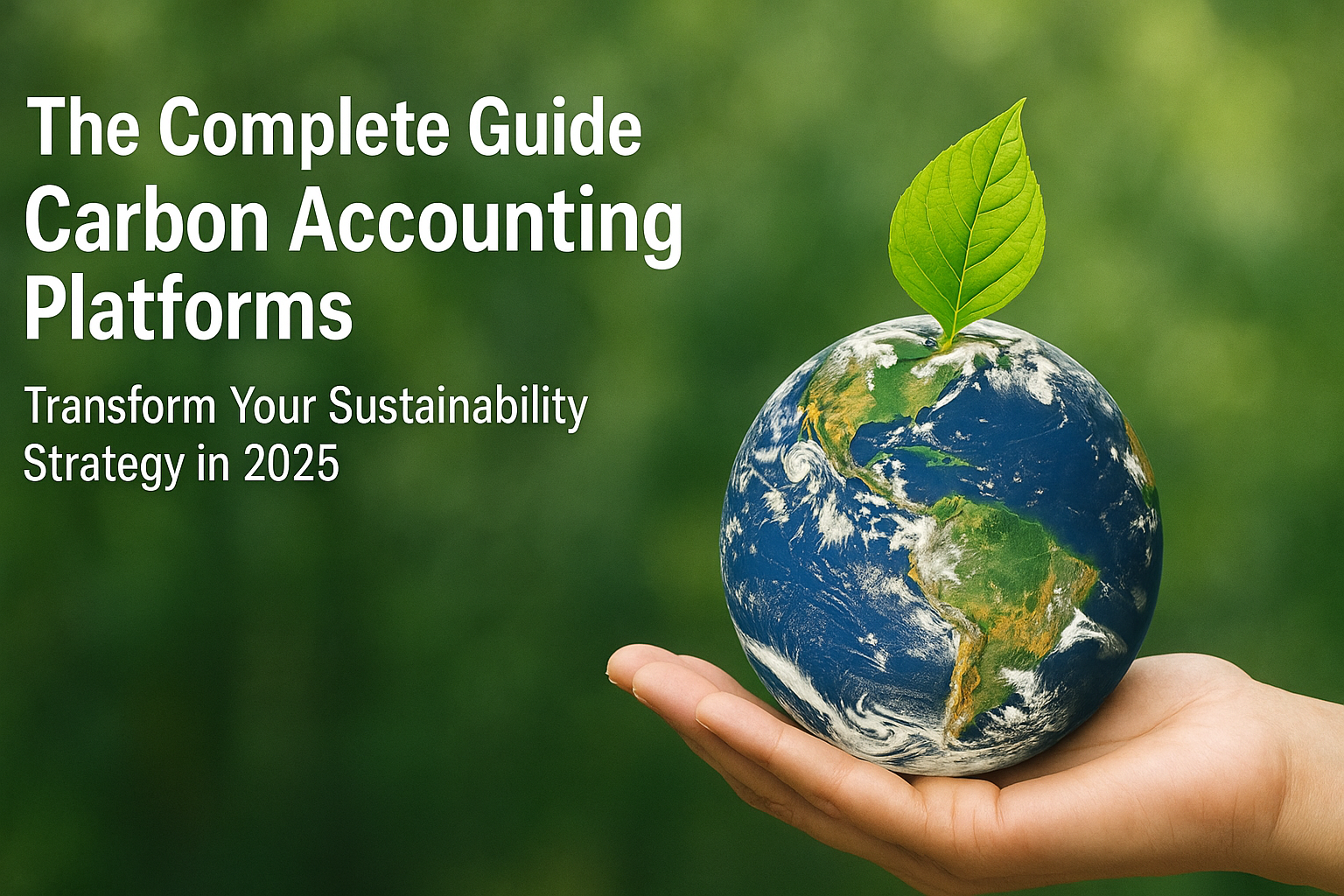Understanding the three scopes of greenhouse gas emissions is fundamental to effective carbon accounting. Whether you're just starting your sustainability journey or looking to refine your existing approach, this comprehensive guide will help you master the basics of Scope 1, 2, and 3 emissions.
What Are Emission Scopes?
The Greenhouse Gas Protocol, the world's most widely used greenhouse gas accounting standard, categorizes emissions into three distinct scopes. This framework helps organizations systematically identify, measure, and manage their carbon footprint across their entire value chain.
Scope 1 Emissions: Direct Emissions
Scope 1 emissions are direct greenhouse gas emissions that occur from sources owned or controlled by your organization. These are emissions you have direct control over and can immediately impact through operational changes.
Examples of Scope 1 Emissions:
- Fuel combustion: Natural gas for heating, diesel for generators, gasoline for company vehicles
- Process emissions: Chemical reactions in manufacturing, cement production, steel making
- Fugitive emissions: Refrigerant leaks from air conditioning, methane leaks from equipment
- Mobile combustion: Company-owned cars, trucks, ships, and aircraft
How to Calculate Scope 1 Emissions:
The basic formula is: Activity Data × Emission Factor = CO2 Equivalent Emissions
For example, if your facility uses 1,000 cubic meters of natural gas per month, you would multiply this by the emission factor for natural gas (approximately 2.0 kg CO2e per cubic meter) to get 2,000 kg CO2e per month.
Scope 2 Emissions: Indirect Energy Emissions
Scope 2 emissions are indirect emissions from the generation of purchased electricity, steam, heating, and cooling consumed by your organization. While you don't directly control these emissions, you can influence them through your energy purchasing decisions.
Examples of Scope 2 Emissions:
- Purchased electricity: Grid electricity for offices, factories, and facilities
- Purchased steam: Steam from district heating systems
- Purchased heating/cooling: District heating and cooling systems
Location-Based vs. Market-Based Approach:
There are two methods for calculating Scope 2 emissions:
- Location-based: Uses average emission factors for the electricity grid where consumption occurs
- Market-based: Uses emission factors from specific electricity suppliers or renewable energy certificates
Scope 3 Emissions: Other Indirect Emissions
Scope 3 emissions are all other indirect emissions that occur in your value chain, both upstream and downstream. These often represent the largest portion of an organization's carbon footprint, typically 70-90% of total emissions.
The 15 Categories of Scope 3 Emissions:
Upstream Activities:
- Purchased goods and services: Emissions from production of purchased products
- Capital goods: Emissions from production of purchased capital equipment
- Fuel and energy-related activities: Extraction, production, and transportation of fuels
- Upstream transportation and distribution: Transportation of purchased products
- Waste generated in operations: Treatment and disposal of waste
- Business travel: Employee travel for business purposes
- Employee commuting: Employee travel between home and work
- Upstream leased assets: Operation of leased assets not included in Scope 1 & 2
Downstream Activities:
- Downstream transportation and distribution: Transportation of sold products
- Processing of sold products: Processing of intermediate products by third parties
- Use of sold products: End use of goods and services sold
- End-of-life treatment of sold products: Waste disposal and treatment
- Downstream leased assets: Operation of assets owned by the reporting company
- Franchises: Operation of franchises not included in Scope 1 & 2
- Investments: Operation of investments (for financial institutions)
Why All Three Scopes Matter
Understanding and measuring all three scopes is crucial for several reasons:
Complete Picture
Only by measuring all three scopes can you understand your organization's true climate impact and identify the most significant opportunities for reduction.
Regulatory Requirements
Many regulations now require comprehensive emissions reporting across all scopes, including the EU's Corporate Sustainability Reporting Directive (CSRD) and various national climate laws.
Stakeholder Expectations
Investors, customers, and partners increasingly expect transparency on all emissions, not just those directly controlled by your organization.
Science-Based Targets
Setting science-based targets typically requires including Scope 3 emissions, especially for companies where they represent a significant portion of the total footprint.
Getting Started: A Step-by-Step Approach
Step 1: Start with Scope 1 and 2
Begin with emissions you have direct control over. These are typically easier to measure and manage, providing a solid foundation for your carbon accounting program.
Step 2: Conduct a Scope 3 Screening
Identify which of the 15 Scope 3 categories are relevant to your business and estimate their relative significance.
Step 3: Prioritize Based on Materiality
Focus your detailed measurement efforts on the categories that represent the largest emissions and greatest opportunities for reduction.
Step 4: Develop Data Collection Systems
Establish processes for regularly collecting activity data across all relevant emission sources.
Step 5: Set Targets and Track Progress
Use your baseline emissions data to set reduction targets and track progress over time.
Common Challenges and Solutions
Data Availability
Challenge: Difficulty obtaining activity data, especially for Scope 3 emissions.
Solution: Start with available data and use estimation methods. Improve data quality over time through supplier engagement and better data systems.
Double Counting
Challenge: Risk of counting the same emissions in multiple categories.
Solution: Clearly define organizational boundaries and follow established protocols for categorizing emissions.
Resource Constraints
Challenge: Limited time and budget for comprehensive emissions measurement.
Solution: Use a phased approach, starting with the most material categories and expanding over time.
Tools and Resources
Several tools can help you get started with emissions measurement:
- GHG Protocol Calculation Tools: Free Excel-based calculators for different sectors
- Carbon accounting software: Platforms like CarbonAnalytics that automate data collection and calculations
- Emission factor databases: EPA, DEFRA, and other government databases
- Industry-specific guidance: Sector-specific protocols and best practices
Best Practices for Success
Start Simple
Don't try to measure everything perfectly from day one. Start with what you can measure accurately and expand over time.
Engage Stakeholders
Involve key stakeholders, including suppliers, customers, and internal teams, in your emissions measurement efforts.
Document Everything
Keep detailed records of your methodology, data sources, and assumptions to ensure consistency and enable verification.
Focus on Improvement
Remember that the goal is not perfect measurement but continuous improvement in both measurement accuracy and emissions reduction.
Conclusion
Understanding Scope 1, 2, and 3 emissions is the foundation of effective carbon management. While the task may seem daunting at first, taking a systematic approach and starting with the basics will set you up for long-term success.
Remember that carbon accounting is a journey, not a destination. Start where you are, use the tools available, and continuously improve your approach. With time and effort, you'll develop a comprehensive understanding of your organization's climate impact and be well-positioned to take meaningful action.
Ready to start measuring your emissions? CarbonAnalytics can help you automate the process and ensure accuracy across all three scopes. Contact us to learn more about how we can support your carbon accounting journey.



